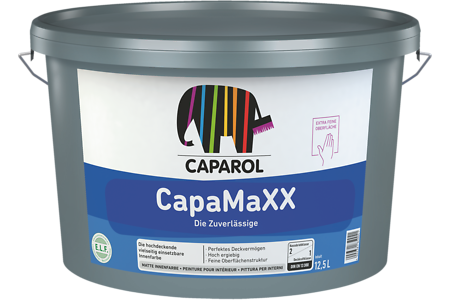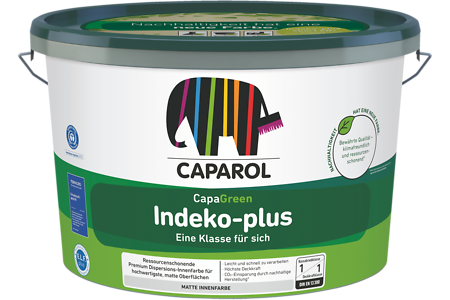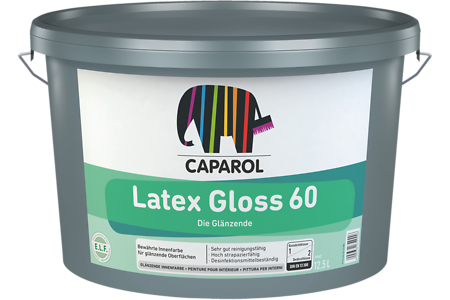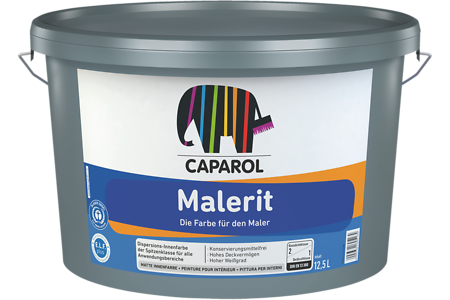Field of Application
Pre-coated Capaver glass fabrics with water-activatable, pre-glued reverse side for efficient application using water bath unit.Capaver glass fabrics provide for highly attractive, high-grade and individual wall surfaces, due to variations in texture, type, colour shade, gloss level and application technique of topcoats.
In accordance with the expected degree of stress or desired visual appearance, all fabrics may easily be coated with suitable paints and economic renovations are possible, due to individual needs.
Material Properties
- Suitable for all usual wetting units.
- Homogeneous, pronounced texture appearance.
- High wet strength.
- Good correctable in the adhesive (glue) bed.
- Rot proof, dimensionally stable.
- Crack bridging.
Material Base / Vehicle
AA type (Aqua Active) fabrics are made of purely mineral glass yarns.
Types that can be delivered
| Type | Texture | Weight per m2 | Roll Size | Rapport |
| 1100 AA | fine | Approx. 170 g | 50 x approx. 1 m | |
| 1132 AA | fine-medium | Approx. 185 g | 50 x approx. 1 m | |
| 2165 AA | herringbone medium | Approx. 245 g | 25 x approx. 1 m | >I 1.6 cm |
| 2180 AA | double chain coarse | Approx. 250 g | 25 x approx. 1 m | |
| 2410 AA | medium | Approx. 240 g | 25 x approx. 1 m |
Packaging/Package Size
Selectable unit: One carton per roll.Storage
Keep Capaver glass fabrics (wall coverings) in a dry place.Note
AA type (Aqua Active) Capaver glass fabrics are composed of glass fibres with a diameter > 5 µm, particles of that size cannot enter the respiratory tract. Although the fibres are highly bonded in the fabric, a limited amount of glass particles may be released when cutting the fabrics. This may cause itching of skin to people with a sensitive skin (suggestion: take suitable protective measures), during application, but will fade away after bonding. Capaver glass fabrics do not release any glass fibres after being coated.
The inner structure of the yarns leads, in combination with an eco-friendly dressing, to a high wet strength, compact fabric surface and high ductility during application.
Glass fabrics of Aqua Active (AA) type are pre-coated in white and therefore usually require only one finishing coat, when matt/silk-matt paints are applied and white or light/pastel shades are used.
Substrates
Interior surfaces: Mineral renders/plasters in mortar groups/classes PI (lime plaster), PII (lime-cementmortars) and PIII (cement mortars), PIV (gypsum mortar and ready-mixed gypsum render/plaster),
sandwich type plaster boards/gypsum plasterboards, gypsum wallboards, concrete.
Surfaces with colour contrast: One previously applied priming coat of Capadecor DecoGrund or Caparol Haftgrund.
Substrate Preparation
The substrate must always be solid, dry, sound/stable, clean, even and free from all substances that may prevent good adhesion. Follow Technical Information No. 650.In Germany: Follow VOB, part C, DIN 18366, section 3.
Lower temperature limit for application and drying: +5 °C (product, substrate and ambient air).
Method of Application
For bonding Aqua Active glass fabrics no adhesive (glue) has to be applied to the substrate! Application is effected in a water bath tray/unit or in a suitable pasting unit with conversion kit:
- Fill the unit with tap (potable) water up to the mark.
- Then inlay the roll in conformity with technical manual and reset the counter (if available).
- After that draw the fabric through the unit in 2/3-1/3 method per length and fold it.
- The adhesive (glue) is quickly self-activating and has reached the optimum adhesive power after approx. 1-3 minutes, depending on the texture.
The time varies depending on conditions on site (temperature and RH). - For application on ceilings a dwell time of 2 - 3 minutes is advisable.
- Longer dwell times may lead to a difficult opening of lengths and undesirable bonding of marginal areas.
- Note: Do not apply wall coverings with a dwell time of > 5 minutes.
- As long as the adhesive (glue) has no contact to the substrate, it can be (even after drying) repeatedly reactivated with tap water.
Bedding/Bonding of Glass Fabrics and Fleeces
- The reverse side of the roll is normally marked and has to be bonded to the wall. To avoid differences of appearance in texture/pattern, always place the fabrics running in one direction and not laterally reversed.
- Capaver glass fabrics should be bonded with butt joints.
- Provide for narrow butt joints, but the forming of bulges must be avoided to achieve a proper visual appearance.
- Important: The horizontal run of yarns (weft yarns) within joining lengths should match at eye level, avoiding an unintentional zipper effect.
- Some fabric types have a pattern repeat, which must be considered for bonding.
- Press the bonded lengths void-free with sufficient pressure to the full surface using wallpaper scraper or pressure roller. Fix the edges and cut of the excess length with a wallpaper scraper.
- For bonding glass fabrics and fleeces on vertical external corners, the length must pass around it for minimum 10 cm. Stiff types: Sand the fibres on edges with a wet sanding pad type P320 (but only a little and very carefully; do not sand through the material) to induce a better pliability and press on.
- For non-vertical external corners, the fabrics must be cut at the corner.
Surface Coating System
Intermediate Coat:The intermediate coat forms the basis to achieve a perfect finishing coat. The intermediate coat can only be applied when adhesive (glue) and fabrics/wall coverings are completely dry, and should be tinted to match the finishing coat in shade.
Apply one filling intermediate coat of Capaver Gewebegrundierung before applying coats of thin film paint, e.g. latex paints.
An intermediate coat may be omitted for coats of matt, white paint, due to the pre-coating of AA types. This should preliminary be checked by a trial coating.
Finishing Coats:
Selection of suitable products for finishing coats is depending on the degree of expected loads and desired gloss level. Coatings must be applied wet-on-wet (also effective for trimming areas).
See the following table for further information.
| Loads | Intermediate Coat | Finishing Coat | Gloss Level | ||
| Product | Work Steps | Product | Work Steps | ||
| NORMAL | CapaTrend Malerit E.L.F. Sylitol Bio-Innenfarbe | 1 | CapaTrend Malerit E.L.F. Sylitol Bio-Innenfarbe | 1 | MATT |
| NORMAL– MEDIUM | CapaMaXX MattLatex CapaSilan NespriSilan | 1 | CapaMaXX MattLatex CapaSilan NespriSilan | 1 | MATT |
| Indeko-plus | 1 | Indeko-plus | 1 | MATT | |
| MEDIUM– HIGH | Amphibolin Latex Samt 10 | 1 | Amphibolin Latex Samt 10 | 1 | Silk matt |
| SeidenLatex | 1 | SeidenLatex | 1 | Silk gloss | |
| Amphibolin | 1–2 depending on colour shade | Metallocryl Interior | 2 | Gloss | |
| EffektGrund | 1–2 depending on colour shade | CapaGold/CapaSilver | 2 | Silk gloss | |
| HIGH | PremiumClean | 1 | PremiumClean | 1 | Silk matt |
| Latex Satin 20 Latex 201 SG | 1 | Latex Satin 20 Latex 201 SG | 1 | Silk gloss | |
| Latex Gloss 60 | 1 | Latex Gloss 60 | 1 | Gloss | |
| EXTREMELY HIGH | Disbopox 447 E.MI Wasserepoxid | 1 | Disbopox 447 E.MI Wasserepoxid | 1 | Silk gloss |
For more details please consult our corresponding Technical Information of above mentioned products.
| Product | Load Capacity |
| CapaTrend Malerit E.L.F Sylitol Bio-Innenfarbe | - Wet scrub resistance Class 3 according to DIN EN 13300 |
| CapaMaXX MattLatex CapaSilan NespriSilan | - Wet scrub resistance Class 2 according to DIN EN 13300 - Resistant to aqueous disinfectants |
| Indeko-plus Amphibolin Latex Samt 10 SeidenLatex Premium Clean Latex Satin 20 Latex 201 SG Latex Gloss 60 Metallocryl Interior CapaGold✱/CapaSilver✱ | - Wet scrub resistance Class 1 according to DIN EN 13300 - Resistant to aqueous disinfectants |
| Disbopox 447 E.MI Wasserepoxid | - Wet scrub resistance Class 1 according to DIN EN 13300 - Resistant to aqueous disinfectants - Highly scratch- and shock-resistant - Chemical-resistant - Decontaminable according to DIN 25415 |
✱Not tested for resistance to disinfectants.
Application Conditions
Ensure proper use of the water wiper, when water bath units are used. A surplus of water on the fabric length may lead to exceeding swelling of adhesive/glue and diminished adhesion. Do not apply wall coverings with a dwell time of > 5 minutes.Drying/Drying Time
Allow bonded lengths of glass fabrics to dry thoroughly before any further coating.
Note
Capaver wall coverings are thoroughly inspected by the manufacturer. In exceptional cases isolated production related weaving faults may occur. These faults are marked at the trimmed edges and correspondingly compensated. They do not entitle to any objection. While cutting and bonding the fabrics (lengths), ascertain whether there are no weaving faults. In case of complaint the label with the batch and product numbers (see original carton) must be kept ready. Claims based on material faults cannot be objected after the application of more than 10 lengths.
German Certificates
- Flame-retardancy according to German standard DIN 4102, B1
- Non-combustibility according to German standard DIN 4102, A2
- Decontaminatibility in combination with Disbopox 447 E.MI Wasserepoxid
| Fire behaviour classification associated with Capaver Glasgewebe AA | |
| Coating | Reaction to Fire: Class |
| CapaTrend | A2 |
| Malerit E.L.F. | A2 |
| CapaMaXX | A2 |
| MattLatex | A2 |
| Indeko-plus | A2 |
| CapaSilan | A2 |
| Sylitol Bio-Innenfarbe | A2 |
| Latex Samt 10 | A2 |
| Latex Satin 20 | A2 |
| Latex Gloss 60 | A2 |
| Amphibolin E.L.F. | A2 |
| Nespri®Silan | B1 |
| SeidenLatex | B1 |
| SG201 | B1 |
| PremiumClean | B1 |
| Disbopox 447 E.MI Wasserepoxid | B1 |
German test certificates for the corresponding products are available via www.caparol.de
Disposal
Materials and all related packaging must be disposed of in a safe way in accordance with the full requirements of the local authorities. Particular attention should be made to removing wastage from site in compliance with standard construction site procedures.In Germany: Dispose Capaver glass fabrics and fleeces as construction site waste.
Customer Service Centre
Tel.: +49 6154 71-71710Fax: +49 6154 71-71711
e-mail: kundenservicecenter@caparol.de
International Distribution: Please see www.caparol.com










